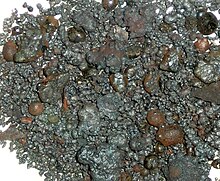

Boron can be prepared in several crystalline and amorphous forms. Well known crystalline forms are α-rhombohedral (α-R), β-rhombohedral (β-R), and β-tetragonal (β-T). In special circumstances, boron can also be synthesized in the form of its α-tetragonal (α-T) and γ-orthorhombic (γ) allotropes. Two amorphous forms, one a finely divided powder and the other a glassy solid, are also known.[1][2] Although at least 14 more allotropes have been reported, these other forms are based on tenuous evidence or have not been experimentally confirmed, or are thought to represent mixed allotropes, or boron frameworks stabilized by impurities.[3][2][4][5] Whereas the β-rhombohedral phase is the most stable and the others are metastable, the transformation rate is negligible at room temperature, and thus all five phases can exist at ambient conditions. Amorphous powder boron and polycrystalline β-rhombohedral boron are the most common forms. The latter allotrope is a very hard[n 1] grey material, about ten percent lighter than aluminium and with a melting point (2080 °C) several hundred degrees higher than that of steel.[6]
Elemental boron has been found in star dust and meteorites, but does not exist in the high oxygen environment of Earth. It is difficult to extract from its compounds. The earliest methods involved reduction of boric oxide with metals such as magnesium or aluminium. However, the product is almost always contaminated with metal borides. Pure boron can be prepared by reducing volatile boron halides with hydrogen at high temperatures.[7][8] Very pure boron, for use in the semiconductor industry, is produced by the decomposition of diborane at high temperatures, followed by purification via zone melting or the Czochralski process.[9] Even more difficult to prepare are single crystals of pure boron phases, due to polymorphism and the tendency of boron to react with impurities; typical crystal size is ~0.1 mm.[10]
- ^ Wiberg 2001, p. 930.
- ^ a b Housecroft & Sharpe 2008, p. 331.
- ^ Donohue 1982, p. 48.
- ^ Lundström, T. (2009). "The solubility in the various modifications of boron". In Zuckerman, J. J.; Hagen, A. P. (eds.). Inorganic reactions and methods. Vol. 13: The formation of bonds to group-I, -II, and -IIIB elements. New York: John Wiley & Sons. pp. 196–97. ISBN 978-0-470-14549-4.
- ^ Oganov et al. 2009, p. 863.
- ^ Lide, D. R., ed. (2003). "Section 4, Properties of the Elements and Inorganic Compounds; Melting, boiling, and critical temperatures of the elements". CRC Handbook of Chemistry and Physics, 84th Edition. Boca Raton, Florida: CRC Press.
- ^ Stern, D. R.; Lynds, Lahmer (1958). "High-Purity Crystalline Boron". Journal of the Electrochemical Society. 105 (11): 676. doi:10.1149/1.2428689.
- ^ Laubengayer, A. W.; Hurd, D. T.; Newkirk, A. E.; Hoard, J. L. (1943). "Boron. I. Preparation and properties of pure crystalline boron". Journal of the American Chemical Society. 65 (10): 1924. doi:10.1021/ja01250a036.
- ^ Berger, L. I. (1996). Semiconductor materials. CRC Press. pp. 37–43. ISBN 0-8493-8912-7.
- ^ Will & Kiefer 2001.
Cite error: There are <ref group=n> tags on this page, but the references will not show without a {{reflist|group=n}} template (see the help page).
© MMXXIII Rich X Search. We shall prevail. All rights reserved. Rich X Search
